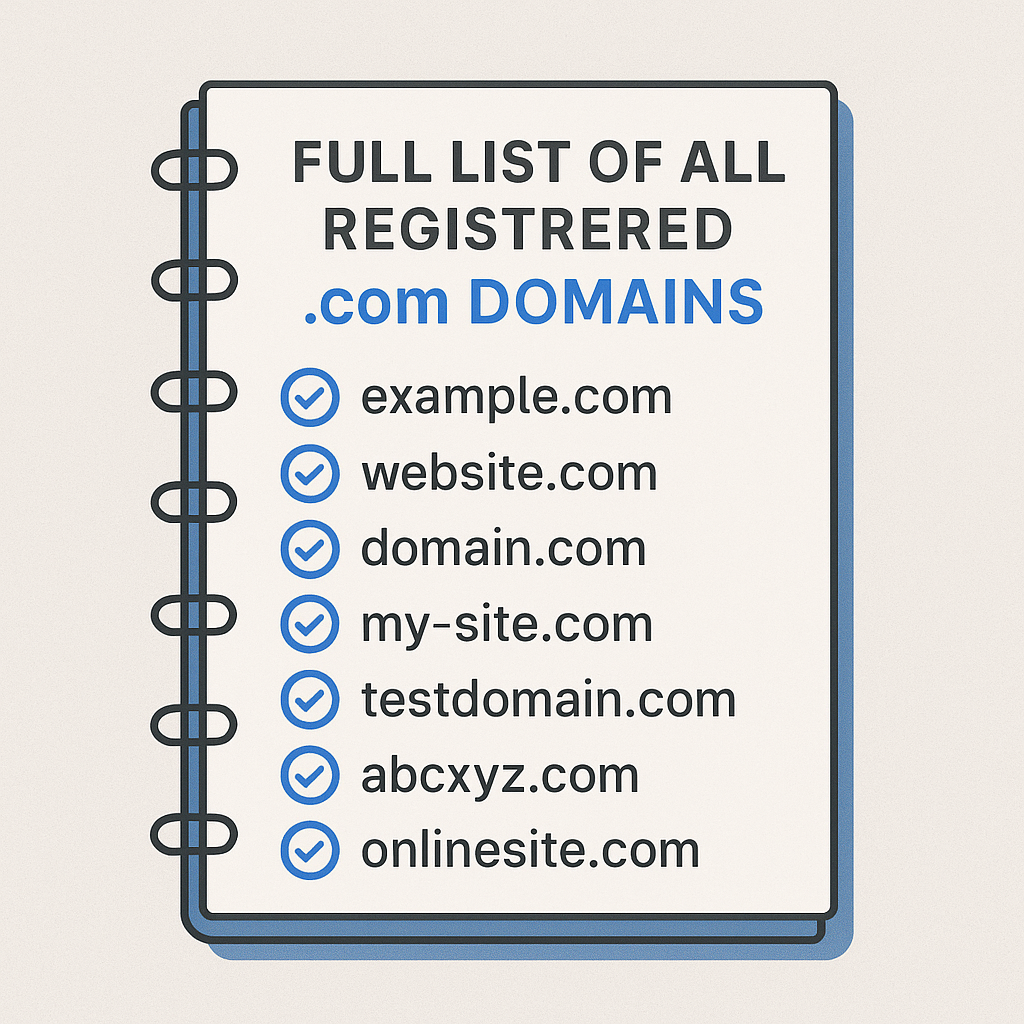Where to Download a Full List of All Registered .com Domains in 2025

Introduction: Unlocking the Power of the .com Domain Universe
In the ever-expanding digital landscape, the .com top-level domain (TLD) remains the undisputed king. [2, 29] It is the most recognized and trusted domain extension globally, hosting millions of businesses, blogs, and online services. [21] For technical specialists, SEO agencies, and marketers, having access to a full list of .com domains is akin to holding the keys to a vast treasure trove of data. This comprehensive database can fuel competitive analysis, supercharge outreach campaigns, identify market trends, and uncover untapped opportunities. This guide will provide an in-depth exploration of how to download a .com domain database in 2025, the various methods available, their associated challenges, and the powerful ways this data can be leveraged.
This article is designed for a technical audience and aims to be the most detailed resource on the internet for acquiring and utilizing a complete list of registered .com domains. We will delve into the official sources, third-party providers, the legal and ethical landscape, and the practical applications for your business.
Chapter 1: The Enduring Legacy and Scale of .com Domains
To truly appreciate the value of a full list of .com domains, it's essential to understand the history and sheer scale of this digital behemoth. The .com TLD was one of the original top-level domains established in January 1985. [6] Initially intended for commercial entities, its use quickly expanded, becoming the default choice for businesses and individuals online. [2] The dot-com boom of the late 1990s solidified its dominance, and despite the subsequent crash, the .com extension has continued to grow. [1, 7]
As of early 2025, there are over 160 million registered .com domains, a number that continues to fluctuate daily with new registrations, expirations, and renewals. [1] This staggering number highlights the immense dataset we are dealing with and the potential insights it holds. The growth of .com domains over the years showcases its enduring popularity and the immense competition for desirable domain names. [11]
The Historical Significance of .com
- 1985: The first .com domain, symbolics.com, is registered by Symbolics Inc., a Massachusetts computer company. [7]
- Mid-1990s: The National Science Foundation begins charging for domain registrations, marking a shift towards the commercialization of the internet. [1]
- Late 1990s - Early 2000s: The dot-com bubble sees a massive surge in .com registrations. [2]
- 2010: The number of registered .com domains surpasses 100 million. [1]
- 2025 and beyond: Despite the emergence of hundreds of new gTLDs, .com remains the most sought-after and valuable domain extension for businesses worldwide. [13]
"The .com domain has come a long way from its humble beginnings in 1985. It has survived booms, crashes, and competition while remaining the most recognizable domain extension in the world."
Chapter 2: How to Access the Full List of .com Domains: The Official Source
For those seeking the most authentic and complete source of all registered .com domains, the answer lies with the entity that manages the .com registry: Verisign. [44] Verisign maintains what is known as the .com zone file. This file is the authoritative record of all active .com domains.
What is a Zone File?
A zone file is a plain text file that contains a mapping between domain names and their associated IP addresses. [4] In essence, it tells the internet's Domain Name System (DNS) where to find a website when you type in a .com address. The .com zone file is a massive, constantly updated list of all active domains under this TLD. [28] It is important to note that the zone file only contains active domains with associated name servers; it does not include domains that are in a hold status, pending deletion, or in a redemption period. [4, 25]
Gaining Access to the .com Zone File via ICANN's CZDS
In the past, accessing the Verisign zone file required a direct application process with Verisign. [3] However, this process is now centralized through the Internet Corporation for Assigned Names and Numbers (ICANN) via their Centralized Zone Data Service (CZDS). [4, 23]
The CZDS portal allows interested parties to apply for access to the zone files of numerous TLDs, including .com. [4] The process generally involves the following steps:
- Create an account on the ICANN CZDS portal.
- Request access to the .com zone file. This will require you to agree to the terms and conditions of use.
- Your request will be reviewed. Approval is not guaranteed and is subject to you agreeing to use the data responsibly.
- Upon approval, you will be granted credentials to access the zone file via FTP.
It's crucial to carefully read and adhere to the access agreement, which outlines the permitted uses of the zone file data to avoid any legal repercussions. [3]
The Technical Realities of the .com Zone File
Once you gain access, be prepared for a significant technical challenge. The compressed .com zone file is several gigabytes in size, and the uncompressed text file can be upwards of 8-10 gigabytes. [3] Attempting to open this file with a standard text editor will likely crash your computer. [28] You will need to utilize command-line tools or write custom scripts to process this gargantuan file.
Chapter 3: Third-Party Providers: The Convenient Alternative
For many, the process of obtaining and parsing the official .com zone file is a daunting task. This has given rise to a market of third-party data providers who offer a more convenient way to download a .com domain database. These services have already done the heavy lifting of acquiring, parsing, and often enriching the domain data.
One such provider is Webtrackly, which offers a pre-packaged and regularly updated list of all registered .com domains. This can be a significant time and resource saver for businesses and individuals who need the data without the technical overhead.
Comparison of Data Providers
| Provider | Data Offered | Format | Update Frequency | Key Features |
|---|---|---|---|---|
| Webtrackly | Full list of .com domains, often with additional metadata. | CSV, TXT, or database formats. | Daily or weekly updates. | Cleaned and parsed data, easy to download and use, additional enriched data available. |
| NetworksDB | Lists of registered domains for various TLDs, including .com. [14] | Zipped text files. [14] | Regularly updated. [14] | Offers both free and paid lists, with options for complete packages. [14] |
| Zonefiles.io | Daily updated .com zone file with additional details like unique IPs, active websites, and sometimes contact information. [16] | Compressed .gz format. [16] | Daily. [16] | Provides statistics and enriched data alongside the raw domain list. [16] |
| Whois Data Center | Offers access to a database of registered domains, including historical data. [37] | Database access or downloadable files. | Daily updates for newly registered domains. [37] | Provides WHOIS data, which may include registrant information (subject to privacy regulations). [37] |
Benefits of Using a Third-Party Provider
- Convenience: The data is pre-processed and ready to use.
- Time-Saving: Eliminates the need to apply for access and develop parsing scripts.
- Enriched Data: Many providers offer additional valuable data points, such as website technology, traffic estimates, and contact information (where legally permissible).
- Customer Support: Access to support if you encounter issues with the data.
Chapter 4: The Legal and Ethical Landscape: A Crucial Consideration
When you seek to download a full list of all registered .com domains, you are entering a territory governed by strict data privacy laws. It is imperative to understand and comply with these regulations to avoid significant legal and financial penalties. [45]
GDPR and Other Data Protection Laws
The General Data Protection Regulation (GDPR) in the European Union has had a profound impact on how personal data is handled globally. [9] WHOIS data, which traditionally provided contact information for domain registrants, has been largely redacted to protect privacy. [10] When acquiring a list of domains, especially if it includes any data that could be linked to an individual, you must ensure that the data was collected and is being used in a GDPR-compliant manner.
Other jurisdictions have similar laws, such as the California Consumer Privacy Act (CCPA). [10] It is your responsibility to understand the legal framework that applies to your intended use of the domain data. [38]
Ethical Considerations
Beyond the legal requirements, there are ethical considerations. How will you use this data? The primary purpose for most legitimate businesses is for analysis, market research, and targeted outreach. Using a downloaded .com domain database for spamming or other malicious activities is not only unethical but will also likely violate the terms of service of the data provider and could lead to your business being blacklisted.
"As privacy legislation continues to evolve, ICANN has been focused on implementing policies and building systems to facilitate access to registration data... while at the same time complying with the law. The ongoing goal is to strike a balance between securing individual privacy rights and maintaining the safety and security of the Internet." - ICANN [9]
Chapter 5: Processing and Analyzing the .com Domain Database
You have successfully acquired the all registered .com domains list. Now what? The next step is to process and analyze this massive dataset to extract actionable insights. This is a significant undertaking that requires the right tools and techniques. [36]
Parsing the Data
If you have downloaded the raw zone file, the first step is parsing. [28] This involves extracting the domain names from the file and structuring them in a usable format, such as a CSV file or a database table. [30] Given the size of the file, you will likely need to use programming languages like Python or Perl with libraries designed for handling large files. [8] It's recommended to process the file in chunks to avoid memory errors. [36]
Essential Tools for Domain Data Analysis
Once your data is in a structured format, you can use a variety of tools for analysis:
- Programming Languages (Python/R): These are powerful tools for data manipulation, analysis, and visualization. Libraries like Pandas for Python and dplyr for R are essential. [15, 22]
- Databases (SQL): For a dataset of this size, a relational database like PostgreSQL or MySQL is highly recommended. SQL allows you to efficiently query and filter the data. [19]
- Big Data Technologies (Apache Spark): For extremely large-scale analysis, tools like Apache Spark can distribute the processing across multiple machines. [15]
- Business Intelligence (BI) Tools (Tableau, Power BI): These tools are excellent for creating interactive dashboards and visualizations to explore the data and present your findings. [18]
Example Python Script for Processing a Large Domain List
import pandas as pd
# Example of processing a large CSV in chunks
chunk_size = 1000000
for chunk in pd.read_csv('full_com_domains.csv', chunksize=chunk_size):
# Process each chunk here
# For example, find domains containing a specific keyword
interesting_domains = chunk[chunk['domain_name'].str.contains('your_keyword')]
print(interesting_domains)
Chapter 6: Strategic Applications for SEO Agencies and Marketers
The true value of a full list of .com domains is realized when it is applied to solve real-world business problems. For SEO agencies and marketers, the possibilities are vast.
In-Depth Competitor Analysis
With a complete list of .com domains, you can conduct unparalleled competitor analysis. [20] You can identify all websites in a specific niche, analyze their domain names, and, by enriching the data, gain insights into their online strategies. This can help you understand market saturation, identify key players, and uncover their strengths and weaknesses. [40]
Enhanced Outreach and Link Building
A comprehensive domain database is a goldmine for outreach campaigns. You can filter for websites in your target industry and then use other tools to qualify them for link-building opportunities. For example, you can identify all blogs related to your niche and then reach out to them for guest posting opportunities. This targeted approach is far more effective than casting a wide net.
Market Research and Trend Identification
By analyzing the domain names themselves, you can identify emerging trends. Are there an increasing number of domains being registered with certain keywords? This could indicate a growing market or a new trend. You can also analyze the age of domains to understand the maturity of different market segments. [39]
Lead Generation
For B2B companies, the list of .com domains can be a powerful lead generation tool. You can identify businesses in your target market and then use other channels to connect with them. For example, a web design agency could identify businesses with outdated websites and offer their services.
Use Cases for a .com Domain Database
| Use Case | Description | Target Audience |
|---|---|---|
| Competitor Landscaping | Identify all potential competitors in a given niche or industry. | SEO Agencies, Market Researchers |
| Targeted Outreach | Build highly targeted lists for link building, PR, and sales. | Marketers, Sales Teams |
| Market Trend Analysis | Analyze domain registration patterns to identify new market trends and opportunities. | Business Strategists, Investors |
| Brand Protection | Monitor for domain registrations that infringe on your trademarks. | Legal Departments, Brand Managers |
| Academic Research | Study the evolution of the internet and online business. | Researchers, Academics |
Chapter 7: The Future of Domain Data and Alternatives to .com
While .com remains the dominant TLD, the domain landscape is evolving. [11] The introduction of hundreds of new generic top-level domains (gTLDs) has provided more options for businesses. [5] While a full list of .com domains is incredibly valuable, it's also worth considering the broader domain ecosystem.
The Rise of New gTLDs
Extensions like .io, .ai, .tech, and .store have gained popularity in specific industries. [13] For a truly comprehensive market view, you may want to acquire lists for these TLDs as well. However, for general-purpose business and brand recognition, .com still holds the most weight. [29]
The Impact of AI on Domain Analysis
Artificial intelligence and machine learning are set to revolutionize how we analyze domain data. [24] AI can be used to predict the value of domains, identify patterns that are not apparent to human analysts, and even automate the process of finding high-quality outreach targets. As these technologies mature, the insights we can glean from a downloaded .com domain database will only become more profound.
Conclusion: Your Gateway to Unlocking Digital Intelligence
Acquiring a full list of all registered .com domains is a significant undertaking, but the potential rewards are immense. Whether you choose to go through the official channels of ICANN and Verisign or opt for the convenience of a third-party provider like Webtrackly, this data can provide a powerful competitive advantage. [14, 16]
From deep-diving into your competitors' strategies to fueling highly targeted marketing campaigns and uncovering nascent market trends, the applications are limited only by your imagination. By approaching this endeavor with a clear understanding of the technical challenges, legal responsibilities, and strategic opportunities, you can unlock a new level of digital intelligence for your organization.
The digital world is built on domains, and with a complete list of the most important TLD in hand, you are well-equipped to navigate and succeed in the dynamic online environment of 2025 and beyond.
Frequently Asked Questions (FAQ)
- Is it legal to download a list of all .com domains?
- Yes, it is legal to obtain a list of all public .com domains through official channels like ICANN's CZDS or from reputable third-party providers. However, you must adhere to the terms of use and data privacy regulations like GDPR, especially when it comes to any personal data that may be associated with the domains. [9, 45]
- How large is the full list of .com domains?
- The uncompressed .com zone file is typically over 8 gigabytes and contains over 160 million domain names. [3, 1]
- Can I get a list of all .com domains for free?
- While accessing the .com zone file through ICANN's CZDS doesn't have a direct cost, it requires a formal application and technical expertise to handle the large file. [23] Some third-party providers may offer small, free samples of their domain lists. [14]
- What is the best format to download the domain list in?
- For ease of use, a CSV or a database format (like SQL) is generally preferable to a raw text file. These formats are readily importable into data analysis tools. [35]
- How often is the list of .com domains updated?
- The official .com zone file is updated daily. [4] Reputable third-party providers also update their lists frequently, often on a daily or weekly basis. [16]




